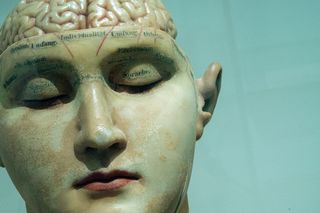OCD
OCD Isn’t a Thought Problem, It’s a Feeling Problem
The real culprit of OCD may not be what you originally thought.
Posted December 27, 2019 Reviewed by Abigail Fagan
It is not uncommon to hear an OCD sufferer make a comment such as “OCD thoughts are ruining my life,” or “I have to get rid of these thoughts!” This refrain is echoed by many of my clients who lament their unwanted, intrusive thoughts and the seemingly endless struggle to suppress, neutralize, and explain away their thoughts.
The common belief, whether explicit or implicit, is that the presence and content of the thoughts are the problem, and getting rid of them will restore hope, confidence, and happiness.
But OCD is not a thought problem — it's a feeling problem. In other words, if the thought did not have the accompanying painful feeling, you would ignore the thought, call it “weird,” and simply move on without compulsions or a second thought.
Allow me to unpack this as it may seem like what I’m saying is controversial or missing some important point about OCD.
Obsessive Compulsive Disorder is a condition marked by a pattern of unwanted, intrusive thoughts, feelings, images, sensations, or urges that take the form of a Feared Story. This story tells the sufferer of a potential, and as of yet fictional, outcome or truth about their actions, intentions, character, or future. This story, being completely unwanted, makes the sufferer feel an overwhelming sense of anxiety.
To deal with this anxiety and to get back to a sense of normalcy, confidence, and comfort, the OCD sufferer will then engage in overt or covert compulsive behaviors as an anxiety management strategy. Compulsions can include avoidance, reassurance seeking, mental review, rituals, and other repetitive acts. Once done, the sufferer gets a false sense of security that unfortunately reinforces the anxiety cycle.

OCD’s deception is that you have to struggle with and resolve the content of the thought. You have to clarify, rectify, and examine the thoughts to determine whether they are true or false. For example, the contamination OCD sufferer believes he must be sure that his hands are fully clean, or at least clean enough, before they can interact with anyone.
In the brief overview of the OCD cycle above, you likely noticed that I mentioned thoughts and feelings. Wouldn’t this suggest that OCD is both a thought and a feeling issue? Yes, but in practice not really. People with OCD often get wrapped up in three potential issues; the trigger, the feared story, and the feeling. Ultimately, freedom from OCD requires you to face down the feeling, because OCD is a feeling problem.
The Trigger
OCD can be triggered by almost anything, including things we see, random thoughts we have, sensations we experience, and objects we encounter. Everything that you and I will ever encounter, think, feel, or experience is neutral until we place some value upon it. Meaning it is neither good nor bad, right nor wrong. Is a knife good or bad? It can be used to open to letter, but it can also be used to open a person. How about therapy? It is both good and bad. It can bring about profound positive life transformation, but it can also be emotionally draining, time-consuming, and costly.
Likewise, triggers to one’s fears are also neutral. Yet those with OCD and anxiety disorders exaggerate the meaning and importance of triggering thoughts or images as they relate to the Feared Story.
Each fear has any number of neutral associations. Remember the knife example? It doesn’t have just one meaning or significance. A knife can conjure thoughts of cooking shows. It can cause someone to think of their dad’s fishing knife or Julius Caesar. The thought of a knife can also spark thoughts of suicide, harm, or crime.
If you blame the trigger (i.e. the feared thought or object) and label it as the problem, you are being misdirected. OCD, and the history of repeated compulsions, exaggerate the importance of a select number of mental associations. Over time, the other neutral or positive associations are downplayed or ignored leaving the feared associations as seemingly the only associations for these thoughts or experiences.
When you scapegoat the trigger as the problem, you believe minimizing your contact with it will make the obsession about it go away. Unfortunately, avoiding the trigger leads to isolation and reinforces the false notion that the trigger is the problem, resulting in greater fear of the trigger and the feared story it spawns.
The Feared Story
Our brain tells us stories all day. Some we like. Some we don’t. OCD tells us stories too, and they are catastrophic, threatening, and at odds with who we are. These Feared Stories are a combination of distorted thoughts and mental images about the result of actions, one’s character, or an inevitable future that concludes in something terrible.
Some people blame the Feared Story as the problem within OCD. They think that if they were to simply get rid of the thoughts, think the opposite of the thought, prove that the thought is wrong, or simply “just think right” that their OCD would evaporate. They believe OCD is a thought problem.
To their point, treatment for OCD and anxiety disorders commonly begins by challenging the feared story using rational thought to develop a broader, reality-based view of the fear. This exercise helps the sufferer develop confidence that their intrusive thoughts are likely irrational, overvalued, and not deserving of excessive and exhausting compulsive responses.
When I challenge the Feared Story in session, my clients are quick to point out how their Feared Story is wrong. They usually say, “I know this doesn’t make sense,” then proceed to point out all the reasons why it doesn’t make sense, and they are right!
For example, a client with Pedophile OCD (POCD) might say, “I’m not a pedophile because I’ve never been attracted to a child in the past. I’ve never wanted to do anything sexual with a child. Whenever I have the thought about molesting a child, I always get anxious and have never felt feelings consistent with my typical feelings of attraction when I think about adults.”
Generally speaking, people with OCD are capable of combating their feared thoughts with rational alternatives. However, compulsions exist because a feared thought comes with, or takes the form of, an uncomfortable and unwanted feeling that overwhelms the sufferer.
Despite developing a list of rational observations and objections to the Feared Story, it does nothing long term because the issue has never been a matter of “right thinking,” but of an intolerance of the feeling brought on by the Feared Story.
The Feeling
Here is the actual problem of OCD. The feeling. More specifically, it is the feeling that makes you engage in compulsive behavior, which subsequently reinforces the OCD cycle. Chasing down and embracing that feeling with a welcoming and accepting posture desensitizes you to the feeling over time. Conversely, if you are unwilling to feel the feeling, but instead rely on compulsions and avoidances, desensitization cannot happen.
Remember, we are able to acknowledge that the trigger is neutral, and has a number of alternative associations. Additionally, we are very capable of telling ourselves why the Feared Story is irrational and wrong. However, we are unable to convince ourselves to not feel something because feelings are largely out of our control.
While not bad or wrong, feeling anxiety in an OCD moment is unwanted. Typically speaking, we say anxiety feels bad, but it by itself is not “bad.” It is an unwanted feeling state at the moment you’re feeling it. When we ride a roller coaster or see a horror movie, we expect to feel butterflies in our stomach, feel our heart racing, and feel jumpy. You know, anxiety feelings. But in this context, we paid good money for the experience! So, the feeling itself is not bad, just unwanted at that moment and inconsistent with the level of actual risk.
Similarly, when it comes to OCD, sometimes the feeling isn’t just anxiety, but sadness, loneliness, anger, apathy, or emptiness.
The goal of Exposure and Response Prevention treatment is to intentionally feel this feeling, acknowledge this inconsistent emotional response, and let it remain without compulsive behaviors until it passes. Remember, it will always pass.
Counterintuitively, your job in Exposure and Response Prevention is to engage the feeling. It’s the enemy and the problem. The solution is to show that you’re stronger than it by calling its bluff that the feeling is heralding in something terrible and that you are not strong enough to shoulder the uncomfortable experience. You are strong enough, and the terrible outcome probably is not coming. Stand firm and let the storm pass.
Feel the Pain, See the Results
If you are not ready to do this, you are going to have a hard time overcoming your anxiety. But you can start small, and progressively work up. If you are consistent and keep pushing yourself, you will eventually find more mental and emotional strength and freedom.




